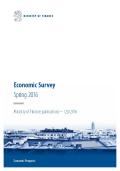Economic Survey, spring 2016
The Finnish economy posted GDP growth of 0.5% in 2015, after three years of recession. In early 2015 the main drivers of slow growth were exports and consumption, towards the end of the year the principal driver was investment.
In 2016 the Finnish economy is expected to grow by 0.9% from last year.
The growth outlook for the global economy and trade is modest. World trade will increase by 3% in 2016, accelerating only slightly to 5% in 2018. The performance of exports will remain weaker than global trade, and therefore Finland will continue to lose market shares. Lower energy prices, and oil prices in particular, are bolstering the growth prospects of energy-intensive economies such as Finland. The sharpest falls in energy and raw material prices have bottomed out, and the price of oil will start to move moderately higher. In 2017 consumer prices will accelerate to 1.3%. Nominal earnings will rise annually by around one per cent over the outlook period. Assuming that these projections are accurate, Finnish competitiveness will improve in comparison with Sweden and Germany, for instance.
Investment will return to clear growth in 2016 and continue to grow on a broad base throughout the outlook period. Private consumption growth will be supported this year by moderate price trends. In 2017–2018 consumption growth will continue to outpace real income growth on the back on strengthening consumer confidence. Projections for 2017 and 2018 forecast muted GDP growth at 1.2%. During the forecast horizon the Finnish economy will grow slightly faster than potential output, and therefore the negative output gap will shrink.
The number of persons employed will turn to growth of 0.3% in 2016 as the economy continues to rebound. Employment will improve throughout the outlook period, and the unemployment rate will drop back to 8.7% by 2018.
Finnish public finances have been running a deficit since 2009. The general government budgetary position will improve in the years ahead in response to fiscal adjustment and rebounding economic growth, but nonetheless remain in deficit. General government debt to GDP has long been rising, and the same trend is set to continue. Finland’s budgetary deficit came within the 3% of GDP target as set out in the EU Treaty, but public debt remains in breach of the 60% limit.
Central government has the largest deficit of all general government sectors, although its deficit is shrinking. Local government finances will also remain firmly in deficit, and other social security funds are gradually moving back to balance. Earnings-related pension institutions are running a deficit of around 1% of GDP.
- Taloudellinen katsaus, kevät 2016
(14.04.2016)

Economic Survey, spring 2016
14.04.2016- Julkaisut
- Valtiovarainministeriö
- Ministry of Finance publications 12b/2016
Talousnäkymät



